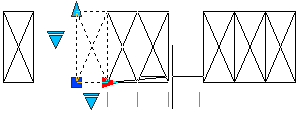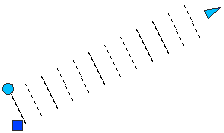In a dynamic block reference, an array action causes its associated objects to copy and array in a rectangular pattern when the associated parameter is edited through a grip or the Properties palette.

In a dynamic block definition, you can associate an array action with any of the following parameters:
After associating an array action with a parameter, you associate the action with a selection set of geometry.
Specify Rows and Columns for an Array Action
When you associate an array action with a linear or polar parameter, you specify the column offset for the arrayed objects. The column offset determines the distance between the arrayed objects. When you edit the parameter in the block reference, the distance of the parameter (from base point to second point) is divided by the column offset to determine the number of columns (the number of objects).
For example, you might associate an array action with a linear parameter. You specify that the array action has a column offset of 2. When you change the linear parameter in the dynamic block reference to a distance of 10, the number of columns for the block reference is 5.
If you associate an array action with an XY parameter, you can also specify the row offset.
Including Parameters in an Array Action's Selection Set
When you include a parameter in an array action's selection set, it has no effect on the behavior of the block reference. The parameter is not copied with the other objects in the selection set. Additional grips are not displayed in the block reference.
In the following example, a parking lot block can be arrayed to contain any number of spaces. The vertical line can also be rotated. Notice that even after the block has been arrayed, it still contains only one rotation grip.

However, when you edit the grip for the parameter included in the array action's selection set, the parameter's associated action is triggered for all instances of the objects. The same behavior occurs when the parameter is not included in the array action's selection set.
Using Rotate and Array Actions in the Same Dynamic Block
A dynamic block can contain an array action and a rotate action that have the same selection set. The order in which the block reference is arrayed and rotated affects the display of the block.
When you rotate the block first and then array it, all instances of the arrayed objects are individually rotated around their own base point.

When you array the block first and then rotate it, all instances of the arrayed objects are rotated around a single base point.
